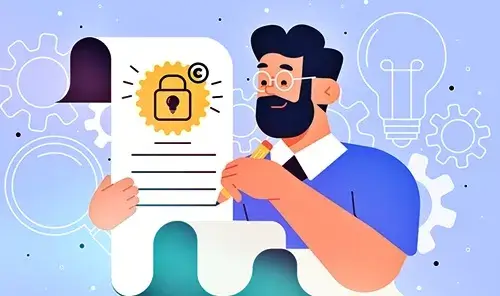Intellectual Property. Very often, companies focus intensely on protecting their tangible assets, their market share, and their customer relationships. Yet, they frequently overlook one of their most dynamic and potentially valuable resources: the intellectual property (IP) created by their employees.
It’s a common oversight, but a significant one- companies sometimes forget that employees don’t just contribute time and skill; they contribute innovation, creativity, and invention. And the outputs of this contribution, the intellectual property objects they create, hold immense value.
Intellectual Property and employees.
This oversight gives rise to serious risks, ranging from costly litigation and damaging disputes with former or current employees to the outright loss of crucial rights to intellectual property assets.
In a world increasingly driven by innovation and intangible value, failing to properly manage and acknowledge employee-created IP is not just unfair to employees; it’s a critical business vulnerability.
In this guide, we delve into the essential aspects concerning intellectual property objects created within the scope of employment, exploring the fundamental principles of ownership and analyzing the various approaches to compensation, including the concept of “royalties” or other forms of recognition and reward for these valuable contributions.
Our aim is to provide a clear, easy-to-understand roadmap for businesses to navigate this complex but vital area successfully.
What Exactly is Employee-Created Intellectual Property?
Before we discuss ownership and compensation, it’s crucial to define what kind of intellectual property we’re talking about.
When we refer to “official intellectual property objects” created by employees, we typically mean inventions, creative works, or proprietary information developed within the scope of their employment, often using company resources (time, equipment, confidential information).
These can take many forms:
Patents.
Protecting new and useful inventions, processes, machines, manufactures, or compositions of matter. If an employee invents something patentable while working on company projects or using company resources, this invention is likely considered employee-created IP.
Copyrights.
Protecting original works of authorship, such as software code, written reports, marketing materials, designs, presentations, training manuals, graphics, music, or video.
Most creative output generated by employees in the course of their jobs falls under copyright.
Trade Secrets.
Confidential information that provides a business with a competitive edge, such as formulas, practices, designs, instruments, or compilations of information.
Employees often develop or gain access to trade secrets as part of their role. While not requiring formal registration like patents or copyrights, maintaining their secrecy is paramount, and employee confidentiality is key.
Trademarks and Designs.
While less commonly created as the core IP by employees in the same way as inventions or code, employees might contribute to the development of logos, branding elements, or product designs which can be protected.
The key distinction for “employee-created” or “official” IP is its connection to the individual’s employment. Was it created on company time? Using company equipment?
Within the employee’s job description or assigned duties? Based on confidential company information or research? These factors significantly influence ownership.
Who Owns What in the Employment Relationship?
This is arguably the most critical and often contentious aspect of employee-created IP. The fundamental question is: When an employee creates something valuable, does it belong to them or to the company? The answer is not always straightforward and depends heavily on several factors:
Employment Contracts and IP Assignment Agreements:
This is the primary determinant in many jurisdictions. A well-drafted employment contract or a separate IP assignment agreement will typically state clearly that any IP created by the employee within the scope of their employment is owned by the company. Employees usually agree to assign all rights to such IP to the employer as a condition of employment.
Company Policies.
Clear company policies regarding IP ownership, confidentiality, and use of company resources further reinforce the employer’s claim to IP created by employees on the job.
Legal Frameworks (“Work-for-Hire”): Some legal systems, notably the United States, have a “work-for-hire” doctrine, particularly strong for copyrights.
Under US copyright law, if a work is created by an employee within the scope of their employment, the employer is automatically considered the author and owner of the copyright from the moment of creation, unless there’s a written agreement to the contrary.
Other countries have different approaches, sometimes granting employees certain non-assignable rights or requiring specific agreements for ownership transfer. Scope of Employment: Even without explicit agreements, courts often consider whether the IP was created “within the scope of employment.”
This typically means the work was: Of the kind the employee was hired to perform.
Occurred substantially within the authorized time and space limits of their job. Actuated, at least in part, by a purpose to serve the employer.
IP created purely on an employee’s own time, without using company resources, and unrelated to their job duties, is generally owned by the employee. However, the lines can blur, making clear agreements essential.
Specific Laws Regarding Inventions.
Some countries have specific laws governing employee inventions (e.g., in parts of Europe), which may grant employees certain rights to compensation or even partial ownership, regardless of contractual clauses, if the invention is particularly significant or if the employer chooses not to exploit it.
Given these variables, companies must be proactive. Relying solely on general legal principles without explicit agreements is a gamble.
Clear, legally sound employment contracts and IP assignment agreements are the cornerstone of securing ownership of employee-created IP. These documents remove ambiguity and provide a solid legal basis for the company’s rights.
Beyond Salary.
The Case for Employee Compensation (Including “Royalties”)
Even when employment agreements clearly state that the company owns all IP created by employees on the job, smart companies understand that the conversation shouldn’t end there.
While a regular salary compensates employees for their time, effort, and skill in performing their duties, it doesn’t always adequately reflect the potential extraordinary value generated by a specific invention, a piece of software code, or a creative work that becomes a significant company asset.
This is where the concept of compensation beyond standard salary comes in, often loosely referred to by employees as “royalties.”
While true royalties (a percentage of revenue or profit generated by the IP) are not always legally required or the standard model in employment, the idea behind them- that employees should somehow benefit when their creations generate significant value for the company, resonates deeply.
Why should companies consider compensating employees for IP, even when they legally own it?
Motivation and Innovation.
Knowing that their innovative contributions might lead to additional compensation or recognition can significantly motivate employees to be creative, solve problems, and develop valuable IP.
If employees feel their best ideas are simply absorbed into the company without any special acknowledgment, their drive to innovate might diminish.
Retention of Talent.
Highly creative and innovative employees are valuable assets. If they feel undervalued or that their contributions aren’t fairly recognized, they may seek opportunities elsewhere, potentially taking their future innovative capacity with them.
Fair compensation for significant IP can be a powerful retention tool.
Fostering a Culture of Innovation.
A company culture that rewards innovation signals that creativity is valued. This encourages employees at all levels to think outside the box and contribute their ideas.
Reducing Risk of Disputes.
While not a guaranteed shield, having a clear policy and a system for compensating significant IP can make employees feel more fairly treated, reducing the likelihood of disputes, claims of unfairness, or even legal challenges to ownership down the line.
An employee who feels fairly compensated for their invention is less likely to contest the employer’s ownership of it.
Attracting Top Talent.
In competitive industries, being known as a company that fairly compensates employees for their innovative contributions can be a significant advantage in attracting top-tier talent.
Models for Compensating Employee IP.
While traditional “royalties” as a percentage of sales might be complex to track and manage for every piece of employee-created IP, companies can implement various effective compensation models:
Invention/Creation Bonuses.
A one-time bonus paid when an invention is disclosed, a patent is filed, or a patent is granted. The bonus amount can vary depending on the perceived significance of the IP.
Success-Based Bonuses.
Bonuses tied to the commercial success of the product or service that incorporates the employee’s IP.
This could be based on revenue milestones, profitability targets, or market adoption. This is closer in spirit to a royalty but is typically a lump sum or series of payments rather than a continuous percentage.
Profit Sharing.
A system where employees involved in creating successful IP share in a portion of the profits generated by that IP or the product/service it enables.
Equity or Stock Options.
Granting employees equity or stock options in the company, allowing them to benefit from the overall growth and success driven, in part, by their innovations. This aligns the employee’s financial interests with the company’s long-term success.
Recognition Programs.
While not direct financial compensation, public acknowledgment, awards, and opportunities for professional development related to their innovative work can be powerful motivators and forms of compensation.
Hybrid Models.
Combining several of the above approaches. For example, a small bonus upon invention disclosure, a larger bonus upon patent grant, and a potential success-based bonus if the patented technology achieves significant commercial success.
Negotiated Agreements for Specific IP.
For particularly significant or groundbreaking IP, the company might enter into a specific agreement with the employee(s) detailing unique compensation terms beyond the standard policy.
The key is to have a transparent, clearly communicated policy outlining if and how employees will be compensated for IP, and what criteria are used to determine the form and amount of compensation. This policy should ideally be referenced in the employment contract.
The High Stakes.
Risks of Ignoring Employee IP Rights and Compensation!
As the initial text snippet correctly points out, neglecting the complexities of employee-created IP carries significant risks.
Litigation and Legal Disputes.
Ownership Challenges. Employees (especially former employees) may challenge the company’s ownership of IP, arguing it was created outside the scope of employment, or that assignment agreements were invalid or unconscionable.
Compensation Claims.
Even if ownership is clear, employees might sue for additional compensation, particularly in jurisdictions with specific laws around employee inventions, or if there were promises (explicit or implied) of reward that weren’t fulfilled.
Trade Secret Misappropriation.
Disputes can arise if an employee leaves and is accused of using or disclosing trade secrets they helped develop or had access to. Clear IP and confidentiality agreements help mitigate this, but disputes can still occur.
Cost and Disruption.
Litigation is expensive, time-consuming, and distracts from core business activities.
Loss of Rights to Valuable IP.
Court Rulings.
A court finding against the company in an ownership dispute can mean losing the rights to critical patents, copyrights, or trade secrets, potentially crippling a product line or business strategy.
Inability to Enforce IP: If ownership is unclear or contested, the company may struggle to enforce its IP rights against third-party infringers.
Patent Invalidation: Lack of clear documentation regarding inventorship and assignment from employees can even jeopardize the validity of a granted patent.
Decreased Motivation.
As mentioned, feeling that innovative contributions are unvalued or unfairly appropriated leads to demotivation.
Erosion of Trust.
A lack of transparency or perceived unfairness regarding IP and compensation can severely damage employee trust in management.
Increased Turnover.
Valuable, innovative employees are more likely to leave for competitors who have clearer, fairer policies regarding IP compensation and recognition.
This results in a loss of talent, knowledge, and future innovation potential.
Reputational Damage.
Negative Publicity: Public disputes with employees over IP can generate negative press, damaging the company’s reputation as an employer and potentially impacting customer perception.
Difficulty Attracting Talent.
A poor reputation regarding employee treatment and IP rights can make it harder to recruit skilled innovators.
Loss of Competitive Advantage.
Inability to Exploit Innovation: If ownership is contested or lost, the company cannot freely use, license, or sell the IP that could be key to its competitive advantage.
Competitors Gaining Access. In the worst cases, losing rights could mean a competitor gains access to technology or creative works that were developed internally.
These risks are not theoretical; they are real possibilities that can have profound and lasting negative impacts on a business’s finances, operations, and future viability.
Building a Robust Framework- Best Practices for Companies.
Fortunately, companies can proactively mitigate these risks by establishing clear processes and policies.
Here are some best practices.
Draft Comprehensive Employment and IP Assignment Agreements: Ensure every employee signs a contract that clearly defines IP ownership, assigning rights to the company for work created within the scope of employment.
Include clauses on confidentiality and non-disclosure to protect trade secrets. Consider separate, more detailed IP assignment agreements for roles where IP creation is a primary function.
These agreements must comply with the laws of the relevant jurisdiction(s).
Implement Clear and Accessible IP Policies.
Develop a company-wide policy outlining how employee-created IP is handled, including ownership, confidentiality, and any compensation or recognition programs.
Make this policy easily accessible to all employees (e.g., in an employee handbook or on the company intranet). Provide training to ensure employees understand the policy.
Define “Scope of Employment” Clearly (Where Possible): While legal definitions apply, job descriptions and project assignments should ideally clarify the types of work expected, which helps define the scope of employment for IP purposes.
Establish a Process for Invention Disclosure and Recognition: Create a formal process for employees to disclose potential inventions or significant creative works they have developed.
Have a committee or designated individual review these disclosures. Implement a system for recognizing employees for their valuable contributions, whether through formal compensation models or other forms of acknowledgment.
Consider Fair Compensation Models.
Evaluate which compensation models (bonuses, success sharing, etc.) are appropriate for your industry, company culture, and financial capacity.
Ensure the criteria for receiving compensation and the method of calculation are transparent. While not always required, offering some form of compensation for truly impactful IP is a strategic move.
Use Confidentiality and Non-Disclosure Agreements (NDAs): Require employees to sign NDAs to protect trade secrets and confidential information.
These should extend beyond the period of employment.
Educate Employees: Regularly educate employees about the importance of IP, the company’s policies, and their obligations regarding confidentiality and assignment of rights.
Help them understand the value of their contributions and how the company’s IP strategy benefits everyone.
Maintain Thorough Records: Keep detailed records of invention disclosures, IP assignments, and any compensation paid related to employee-created IP.
Document the development process of key IP, including who was involved and when.
Seek Legal Counsel: IP law is complex and varies significantly by jurisdiction. It is essential to consult with experienced IP attorneys to draft and review employment agreements, IP assignment clauses, and company policies to ensure they are legally sound and enforceable in all relevant locations.
Regularly Review and Update Policies: Business models, roles, and technologies evolve. Companies should periodically review and update their IP policies and agreements to ensure they remain relevant and effective.
Conclusion.
Employee-created intellectual property is a powerful engine of innovation and a source of significant value for businesses. However, managing it effectively requires more than just assuming ownership.
Companies must acknowledge the creative and inventive contributions of their employees.
While legal frameworks and well-drafted contracts are essential for securing ownership, a forward-thinking approach goes beyond mere legal compliance.
By implementing clear policies, transparent processes, and considering fair compensation or recognition for valuable IP, companies can transform potential areas of conflict into drivers of motivation, retention, and continued innovation.
Ignoring employee IP rights and failing to consider fair compensation creates unnecessary risks – legal battles, loss of valuable assets, damaged reputation, and a demotivated workforce.
Conversely, addressing these aspects proactively fosters a culture of trust, encourages creativity, and strengthens the company’s foundation for future success in an economy where intellectual property is increasingly king.
Properly navigating employee-created IP is not just about legal protection; it’s about smart business strategy and valuing the human ingenuity that drives progress.
Have a Great Day!







